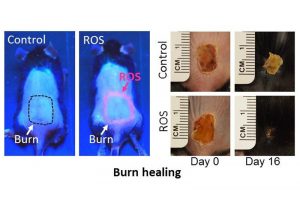09/10/2015
Researchers of the Experimental Dermatology and Cutaneous Biology Group of the Ramón y Cajal Institute of Health Research -IRYCIS- of the Ramón y Cajal University Hospital have shown for the first time, how the production of reactive oxygen species in a tissue of a living organism, in this In the case of the mouse skin, it has a stimulating effect and is capable of activating the stem cells of the tissue, promoting the regeneration of the same.
It is a study coordinated by the researcher Jesús Espada of the Ramón y Cajal Institute of Health Research of Ramón y Cajal and recently published in the prestigious journal Journal of Investigative Dermatology, belonging to the Nature group. This study indicates that the reactive oxygen species -ROS- are extremely toxic so that the cells of the aerobic organisms have developed multiple mechanisms to eliminate them effectively.
However, the biological damage that they produce accumulates progressively in the tissues, associating it with the aging process. Based on these observations, the researchers set out to demonstrate that an endogenous production of reactive oxygen species in a living organism could have physiological stimulating and regulating effects and not simply a defensive response in the tissue.
Amazing results

First, they developed a technology that transiently activates the endogenous production of small amounts of ROS in cells in culture. It is a process that powerfully and in a controlled way stimulates cell proliferation without lethal effects. This procedure is based on the administration of precursors of Protoporphyrin IX -PpIX- to cell cultures. PpIX is a compound that can be synthesized naturally by most of the body’s cells in mammals.
It is also a photosensitive molecule, capable of producing reactive oxygen species from intracellular oxygen when it is illuminated with light of a suitable wavelength, in this case, red light, biologically safe but of high penetrance in organic matter.
The accumulation of precursors in cells results in a peak in the synthesis of PpIX that, when illuminated with red light, induces the transient generation of ROS. The adaptation of this procedure to the skin of the mouse, applying the precursors topically in the form of cream in specific regions of the tissue and subsequent irradiation of the animal in the desired area, obtained surprising results.
Activates the proliferation of skin stem cells
On the one hand, these results have demonstrated for the first time that transiently activate ROS production in the tissue, activate the proliferation of skin stem cells and homeostatic tissue regeneration programs. As a result, it is possible to use the transient production of ROS to dramatically accelerate hair growth or the healing process of burns.
On the other hand, the possibility of applying this procedure in routine clinical practice for the effective and cheap treatment of pathologies and cutaneous lesions that have a high incidence in the population, such as chronic ulcers in elderly and diabetic patients, surgical wounds has been opened , extensive burns or alopecias. In short, it is planned to begin trial of concept tests in volunteers to transfer the results obtained in mouse to human skin.

